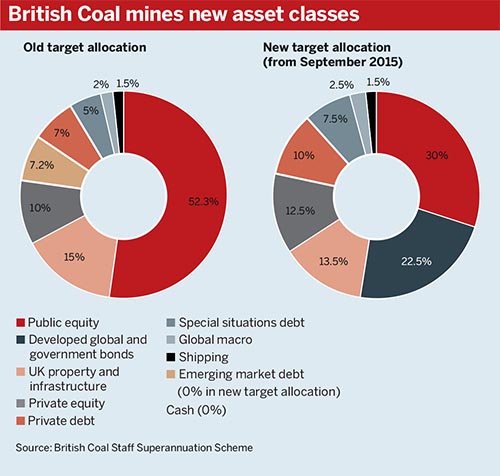The British Coal Staff Superannuation Scheme has revised its asset allocation, which included selling equities and buying government bonds, following changes to the scheme’s structure.
The Pension Protection Fund and the Pensions Regulator’s latest Purple Book, which tracks trends across defined benefit schemes, found that UK schemes have made significant efforts to reduce their equity exposures and increase bonds.
Schemes’ allocation to equities had dropped to 39.4 per cent in 2014, down from 52.6 per cent in 2006. Meanwhile, allocations to fixed income increased to 39 per cent from 22.6 per cent over the same time period.
The £9.6bn British Coal scheme also reduced its equity allocation and started buying government debt, according to minutes from the scheme’s 2015 annual general meeting.
Ships are like floating property. They provide a good yield, are not levered and if you buy them conservatively and cheaply, you help minimise your downside risk
Stefan Dunatov, Coal Pension Trustee Investment
Last year, the once-public sector scheme came to an agreement with its guarantor to end its surplus-sharing arrangement.
Derisking
Dick Barfield, chair of the investment committee at British Coal, told the AGM that the existence of the government guarantee allowed the scheme to invest in assets such as equities and property, which could garner higher returns.
However, he added, as it became more likely that discussions with the government guarantor would reach a conclusion, a big drop in assets could have put any agreement at risk.
The scheme began decreasing its allocation to equities and now has a target public equity exposure of 30 per cent, down from 52.3 per cent. The scheme also introduced a new 22.5 per cent target allocation to developed global and government bonds.
Barfield said the new asset allocation is less risky and should investment conditions worsen, the scheme will not be as badly affected as under the previous portfolio.

He told the AGM: “Of course, we have had to give up some expected future returns for this reduction in risk. But that is fine, as we no longer need to generate surpluses in future.”
In response to the move into government bonds, Stefan Dunatov, chief investment officer of Coal Pension Trustees Investment, which oversees the assets of the scheme, said: “We made an immediate assessment after the review had concluded and decided the appropriate allocation we needed at that time.”
New asset classes
In an unrelated move, the scheme also made initial forays into two new asset classes: shipping and special situations debt.
“Ships are like floating property. They provide a good yield, are not levered and if you buy them conservatively and cheaply, you help minimise your downside risk,” Dunatov said.
He said that since the annual report came out, the scheme has been purchasing ships. “But because it is such an unusual market, the allocation is filling up slowly,” he added. The scheme is currently targeting an allocation of 1.5 per cent.
Dunatov said the special situations debt portfolio was more opportunistic and consists of more unusual types of debt. “There has been a lot more focus on fixed income and that is just a reflection of the scheme maturity and the current expected returns,” he said.
Alternative credit has proved popular with schemes looking to diversify portfolios to add return.
Dan Mikulskis, managing director at consultancy Redington, said that schemes do not have to give up return when they are derisking.
“Something we spend a lot of time with trustees on is how they can reduce risk and maintain returns at the same level,” he said. “The two principal asset classes that we see driving the bulk of schemes’ returns are the liquid market asset class and the liquid credit asset class.”
Mikulskis added: “On the liquid credit front, you have multi-class credit managers who are taking a strategic approach to credit and can change asset allocation and move in and out of sectors, with some investment risk but with pretty good returns. That has seen a big pick-up from simply focusing on investment grade credit.”














